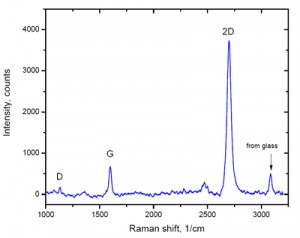History
Raman Spectrometer
Raman Spectrum and Raman Shift Basics
Raman Spectroscopy Video
Surface Enhanced Raman Spectroscopy (SERS)
Coherent Anti-Stokes Raman Spectroscopy (CARS)
Tip-Enhanced Raman Spectroscopy (TERS)
Applications
How Does Raman Spectroscopy Work – The Raman Effect The process involves the inelastic scattering of a beam of monochromatic light by a sample material. Usually, a laser is used for generating this light that interacts with vibrating molecules, phonons or other stimulations in the system. This results in shifting the energy level of the laser photons to oscillate up and down and give information about the vibration patterns of the system, a phenomenon called the Raman Effect. It may be mentioned here that the infrared spectroscopy gives us a similar but complementary knowledge. The portable handheld Raman Spectrometers are used conveniently in industries for quality control of raw materials. They neither need to be in contact with the sample nor require the latter to be pre-treated. Sometimes a Raman probe head is connected to a spectrometer to perform in situ Raman analysis of a sample in industrial settings. Since the said shift is just a difference, it remains unaffected by the value of incident radiation. A look at the spectrum reveals that there are a series of peaks in the graph for different substances that act as the sample. As each material peaks differently, this offers us a way to differentiate between them. One of the disadvantages of Raman spectra is that they are usually very weak in intensity compared to that of Rayleigh scattering. Hence detecting it becomes difficult. Below are a few techniques to strengthen the spectrum.
Resonance Raman (RR) Spectroscopy
This method involves choosing the incident wavelength in such a way so as to overlap with an electronic transition of the molecules or crystals of the sample. It is useful for studying the structures of large molecules such as that of polypeptides. However, there are limitations in the viewing of the spectrum as the associated UV-visible absorption fluorescence may interfere with the emission. In another variant, the Stimulated Raman Spectroscopy, two laser beams are made to coincide with the sample. If the resulting Raman shift matches the frequency of a particular molecular vibration, signal amplification is produced. In Spatially Offset Raman Spectroscopy, spatially offset measurements are used to accurately analyze the chemical structure of matter beneath obscuring surfaces. A new ultrafast technique, called Femtosecond Stimulated Raman Spectroscopy provides the relevant information with high spectral and temporal resolutions. Detecting Crystal Structure – In Polarized Raman Spectroscopy, spectra are obtained after polarization, either parallel or perpendicular to the incident polarization that yields useful information on the molecular orientation and shape of ordered substances such as crystals. Use in Nanoelectronics – Raman Spectroscopy of Graphene and related materials like carbon nanotubes (CNT) and graphite has enabled the scientific community to learn about their properties for gaining an advantage in nanoelectronics and in making nano-sensors, next-generation transistors, transparent electrodes, etc. The method is also beneficial for determining blood glucose concentration in a non-invasive manner. Other Uses – Transmission Raman Spectroscopy helps to examine bulk contents of diffusely scattering substances like powders and tissues. Raman spectroscopy was an important discovery that has made substantial contributions in the fields of Physics and Chemistry though it is not devoid of limitations. These include fluorescence disturbance from impurities in a sample and intense laser heating of the same resulting in the destruction of the sample or covering of the spectrum in extreme cases. https://www.horiba.com/ind/scientific/technologies/raman-imaging-and-spectroscopy/confocal-raman-microscopy/?utm_source=uhw&utm_medium=301&utm_campaign=uhw-redirect https://www.ncbi.nlm.nih.gov/pmc/articles/PMC4839273/ http://mesa.ac.nz/wp-content/uploads/2011/05/Raman-Workshop-Lecture-4-Notes.pdf https://www.physics.purdue.edu/quantum/files/Raman_Spectroscopy_of_Graphene_NOVA_Childres.pdf https://www.researchgate.net/publication/264873022_Characterization_of_carbon_nanotubes_by_Raman_spectroscopy





